Speech Some Current Issues in the Australian Economy

Philip Lowe
Assistant Governor (Economic)
Address to the Committee for Economic Development of Australia (CEDA)
NSW Economic and Political Overview 2011
Sydney –
- Audio 13.31MB
- PDF version
I am very pleased to be able to participate again in CEDA's annual Economic and Political Overview.
In line with the theme of this morning's conference, I would like to discuss a couple of issues that will have an important bearing on economic developments in Australia over the next year or so. The first of these is the performance of the world economy and, in particular, the ongoing strength in global commodity prices. And the second is the continuing evidence of restraint in consumption and borrowing by Australian households. I would also like to talk briefly about the RBA's forecasts that were published in the latest Statement on Monetary Policy (SMP).
The World Economy and Commodity Prices
When I spoke at this conference a year ago, the central forecast for the world economy was that it would grow by around 4 per cent in 2010, with many commentators focussing on the downside risks. Now that most of the GDP figures are in for the year, it looks like global growth was quite a bit stronger than this, with global GDP estimated to be up by around 5 per cent in 2010. There have also been upward revisions to forecasts for 2011, with the IMF now expecting that growth will continue to be above trend in both this year and next (Graph 1).
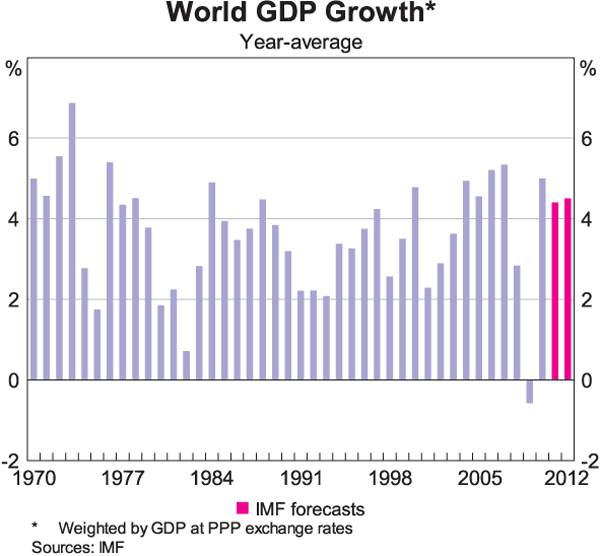
While the recent outcomes for the world economy have been better than expected, significant downside risks remain, not least because of the poor state of public finances in many of the advanced economies. These risks clearly cannot be ignored, although the recent more positive data have led to renewed focus on another risk – that is, a rise in global inflationary pressures, particularly as commodity prices have increased significantly over recent months. As an illustration of this increase, the RBA's own Index of Commodity Prices is at an all time high and has risen by almost 50 per cent over the past year (Graph 2).
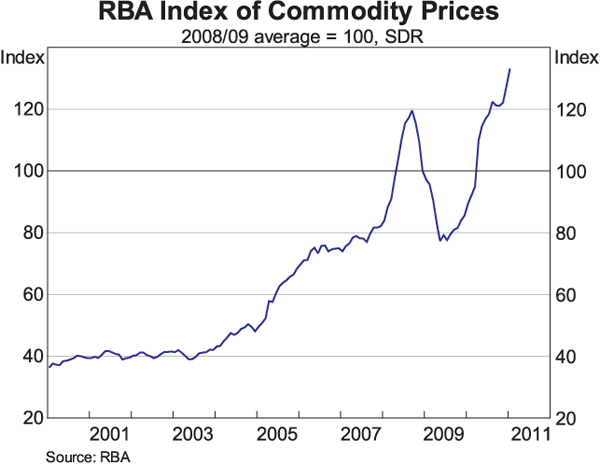
This upward pressure on commodity prices is occurring at a time when conventional measures of the global output gap remain quite large. Many of the advanced economies continue to operate well below full capacity and unemployment rates are still very high. These large output gaps mean that there is little upward pressure on domestic costs and prices in most advanced economies, with core measures of inflation generally still very low. In earlier episodes in which these economies were operating well below potential, there was typically also general softness in commodity markets, with weak demand weighing on prices. Yet, this is not occurring on this occasion. Instead, we are experiencing the co-existence of strong commodity prices and large output gaps in the advanced economies.
The most plausible explanation for this is the continuing shift of global economic weight to the emerging market economies, particularly those in Asia. While industrial production in the advanced economies remains below its 2008 peak, industrial production in Asia has grown very strongly (Graph 3). As a result, there has been strong growth in demand for resources. And similarly, with incomes growing rapidly in the region over a number of years, the demand for agricultural commodities has also been very strong.
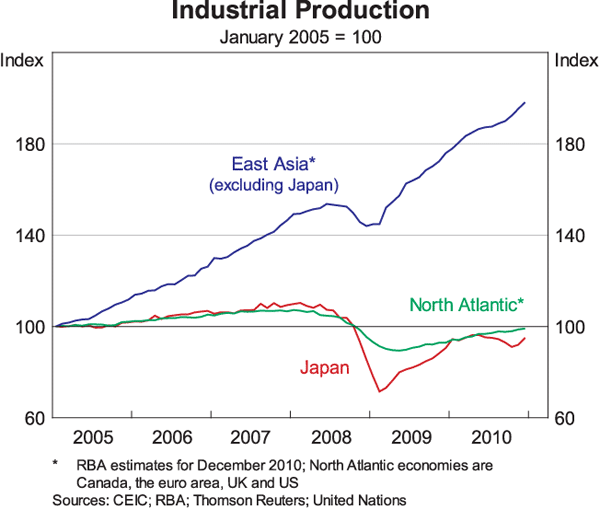
In trying to understand what is going on, it is useful to put these recent developments in a longer-term context.[1] Graph 4 shows an index of global food prices using World Bank data – adjusted for changes in the general price level – back to the beginning of the 20th century. As is evident from this graph, the 1980s and 1990s was a period of unusually low food prices. According to this particular index, between 1982 to 2000, the average price of food was around 30 per cent lower than the average for the previous 80 years. The same general picture applies to the prices of base metals, and to a lesser extent, for iron ore and coal prices (Graphs 5 and 6). More recently, of course, this has all changed, with the relative prices of food, base metals, iron ore and coal all increasing significantly. In the case of iron ore and coal, the prices are now at very high levels compared with their historical averages.
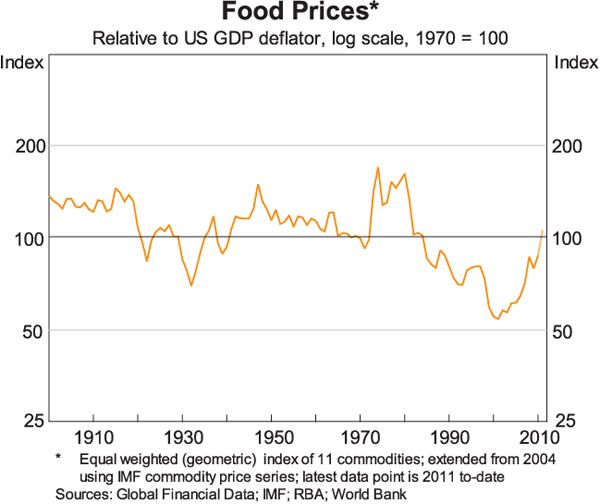
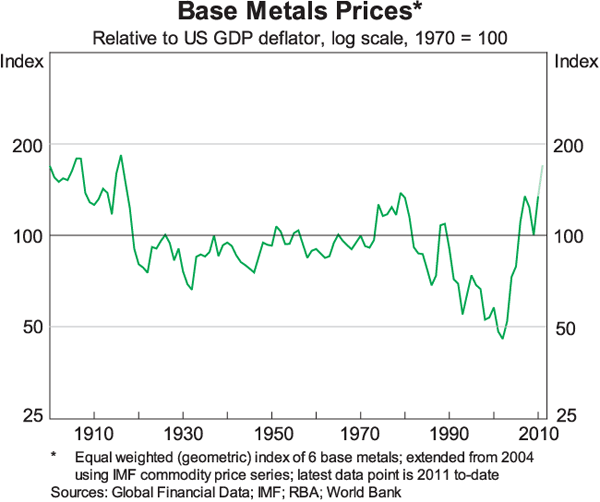
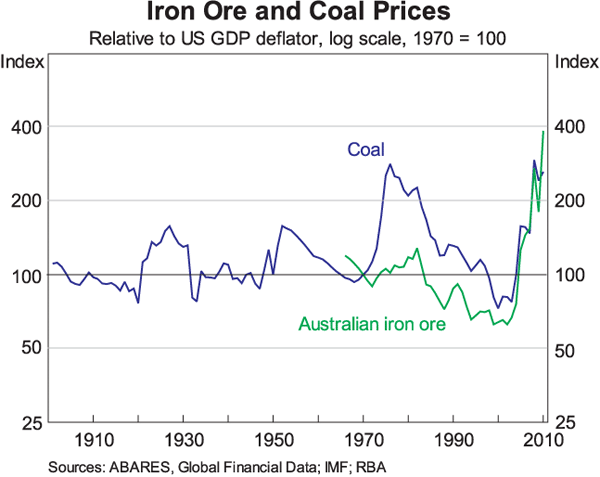
These movements in prices reflect the evolving balance of supply and demand. During the late 1980s and 1990s, the low prices for many commodities led to reduced global investment in exploration and mine development. And in parts of agriculture, the rate of technological progress slowed down with growth in both yields and the land area devoted to crops declining significantly (Graph 7). In effect, low prices meant that the incentive to expand productive capacity was diminished. We saw a clear example of this in Australia, with the level of mining investment (as a share of GDP) in the late 1980s and 1990s lower than it was in the early 1970s and early 1980s, and much lower than it has been over the past decade.
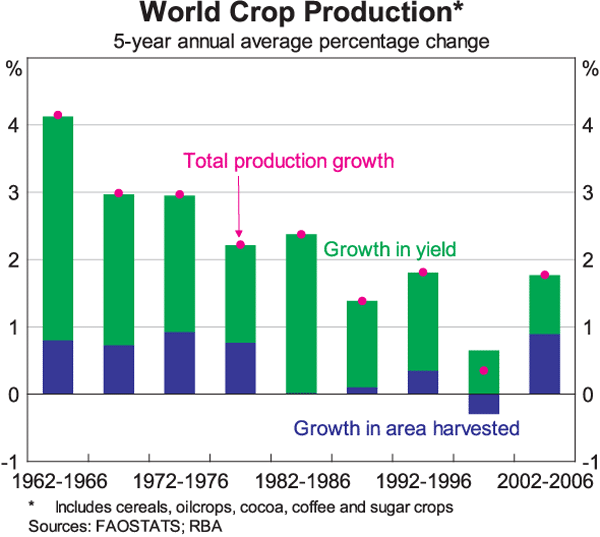
As things have turned out, this period in which the supply side was being pushed out only slowly was immediately followed by a period of very strong growth in demand, largely because of developments in Asia. As I have spoken about previously, the urbanisation and industrialisation of China is very resource intensive, especially in the commodities used to make steel.[2] In addition, the demand for protein has risen rapidly in Asia as average incomes have increased. For many commodities, global inventories are now quite low and it would appear that we are currently operating on a relatively steep part of the global commodity supply curve, with weather-related disruptions adding to the recent price pressures for some commodities.
Looking forward, we cannot be sure about what the future will hold; few people predicted the transformational effects on the world economy of China's growth. At the moment though, there has been some response on the supply side to the high commodity prices, with increased rates of investment in the resources sector. In Australia, we see this more clearly than in most other countries. What is difficult to predict is the time frame over which this increase in global capacity will allow the world economy to again operate on a flatter part of the supply curve. If recent experience is anything to go by, this time may be some way off.
What does seem clearer is that the world economy is going through a change in relative prices, and that this change is likely to be quite persistent. In theory, a change of this sort need not be inflationary for the world, with monetary policy ensuring that the target rate of overall inflation is achieved. And even where a change in relative prices is accommodated by a step up in the overall level of prices, the result need not be ongoing inflation, particularly if inflation expectations do not increase.
In practice though, earlier international experience suggests that things are not always so easy. A complicating factor is that the current change in relative prices is playing out over a run of years and there is uncertainty as to how much of it will be reversed. It can also be difficult for some prices to fall to offset those that are rising. This change in relative prices is also occurring against the backdrop of ongoing stimulatory monetary policy around the world, including in Asia. While in most countries, domestically sourced inflationary pressures remain subdued, there is an important global factor coming from the capacity constraints in commodity markets. At least for the time being, it would appear that the ability of the world to produce commodities is becoming a key constraint on non-inflationary growth for the global economy.
As the Governor said last week at the Parliamentary Hearing, managing these price
pressures in commodity markets is shaping up as one of the major international
issues of 2011. In Asia, the high food prices, in particular, have meant that
headline inflation rates have risen and there has been a lift in inflation
expectations in some countries. If these inflationary pressures were to intensify,
a stronger policy response than seen to date would be likely, increasing the
risk of a subsequent sharp slowdown in the region.
Consumer Restraint
The second issue that I would like to talk about is the restraint in consumer spending and borrowing.
As many retailers will attest, consumer spending has been subdued in recent times. You can clearly see this in the household saving ratio (Graph 8). While there are a whole host of measurement qualifications, the current data show that the saving ratio has increased from a little below zero in the first half of the 2000s to around 10 per cent in 2010. This increase has reversed the steady decline that took place over the previous two decades.
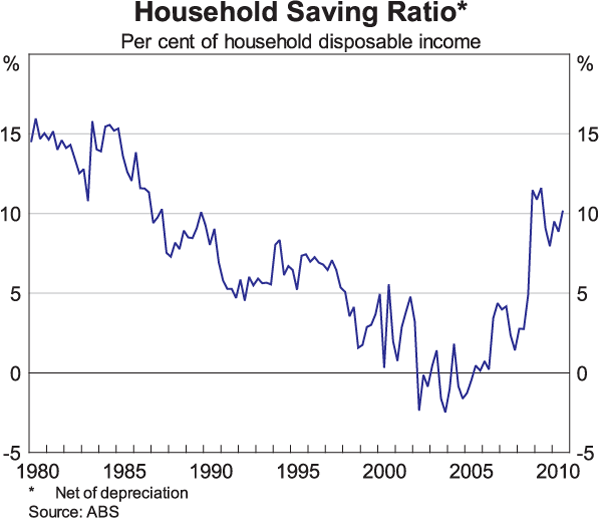
With the benefit of hindsight, a change in the trend looks to have started in the middle of 2000s, although, at the time, this was difficult to detect. Over the decade to 2005, there was a large run-up in household debt and asset prices, and a decline in saving, as households adjusted to lower nominal interest rates and innovation in the financial system. It is plausible that this adjustment was largely completed by the mid 2000s and that since then, household spending patterns have returned to more traditional norms. Over the past few years, this change has been reinforced by the global financial crisis which has led some households to rethink their spending and borrowing decisions, partly in response to greater uncertainty about future asset returns.
A slightly different way of seeing this change is to look at how much of the increase in household incomes each year is actually spent. In quite a few of the years during the decade and a half to 2005, household consumption increased by more than one dollar for every extra dollar of household disposable income received (Graph 9). In contrast, since 2005, only around 65 cents in every extra dollar of income has been spent. It now seems reasonably clear that after a long period of structural adjustment many households are putting a little more aside each month than they were for most of the 1990s and the early 2000s.
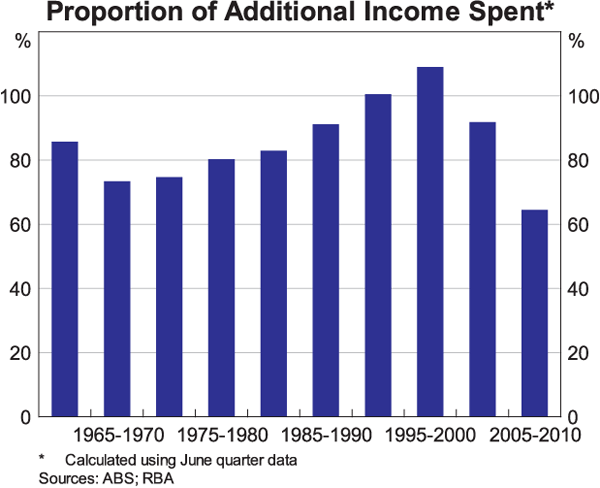
This change can also be seen in a range of other indicators. One example is the disaggregated data available through the annual HILDA survey of household finances. In the surveys that were undertaken between 2000 and 2005, there was a clear trend, with fewer and fewer households with mortgages reporting that they were ahead of schedule in their repayments (Graph 10). However, this downtrend slowed around 2005, and then in 2009 – the most recent year for which data are available – there was a marked increase in the share of people reporting that they are ahead of schedule.
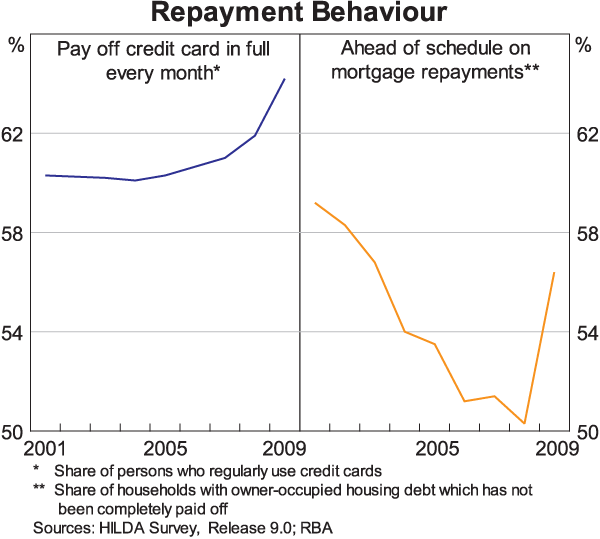
Similarly, over the past couple of years, there has been an increase in the proportion of households who report that they pay their credit card balance in full each month. This change in behaviour is also evident in the responses to the monthly survey of consumers conducted by the Melbourne Institute and Westpac. In particular, over recent years, there has been a marked increase in the number of households that say paying down debt, or building up bank deposits, is the wisest thing to do with their savings (Graph 11). Correspondingly, there has been a decline in the perceived attractiveness of more risky investments.
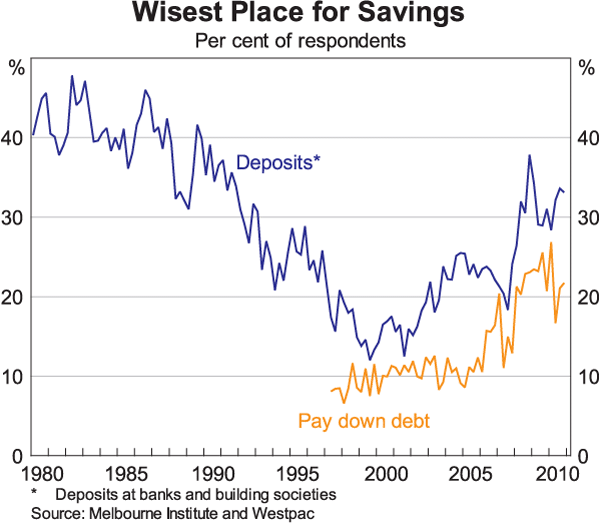
A similar story is also evident in the estimates of how much equity the household sector is adding to the housing stock. Until the late 1990s, it was normal for the value of new investment in housing to significantly exceed the total amount of new housing-related borrowing – in effect the household sector was building up equity in the housing stock. But during the early part of the 2000s this changed and we went to a position in which the household sector was withdrawing equity (Graph 12). Over recent years, things have changed again and we have returned to the more traditional pattern.
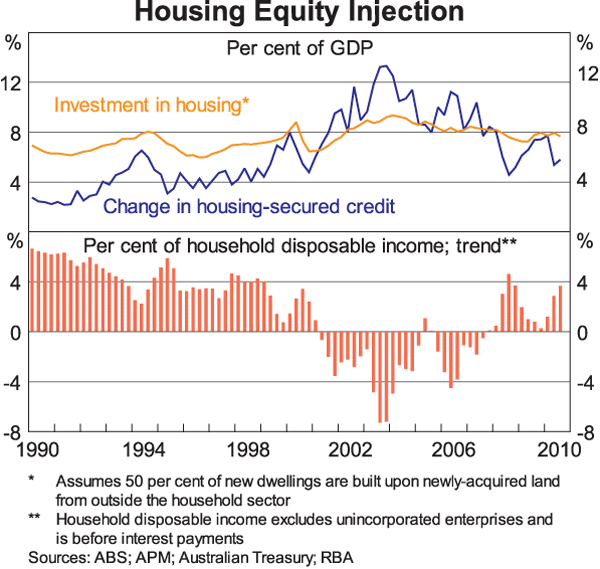
Taking all these indicators together, it seems pretty clear that something has changed in the behaviour of households. It is likely that part of this change reflects the completion of the structural adjustment to lower interest rates and innovation in the financial system. But recently, there also appears to have been a change in attitudes.
As was discussed in the SMP, an important factor shaping the outlook is how persistent this change in attitudes turns out to be. On the one hand, it is plausible that consumption growth will strengthen considerably over the period ahead, supported by strong income growth and an unemployment rate that is trending down. On the other hand, this more cautious approach to spending could be quite long lasting, with households using the strong income growth to further improve their balance sheets. In putting together our forecasts, we have assumed a middle path, with the saving rate staying high, but consumption growth broadly matching income growth over the next couple of years. We will, of course, be looking very closely to see if this is how things evolve.
Before talking about the forecasts in more detail, I would like to draw your attention to one of the side effects of the recent subdued growth in retail spending. And that is the downward pressure on the prices of many retail goods. Over the past year, the ABS's price index for clothing has fallen by 6 per cent (Graph 13). The price index for major household appliances has fallen by 4 per cent. The price index for furniture and furnishings has fallen by 1½ per cent and the price index for audio, visual and computing equipment has fallen by 18 per cent. In fact, there are very few (non-food manufactured) goods in the CPI whose prices have increased over the past year.
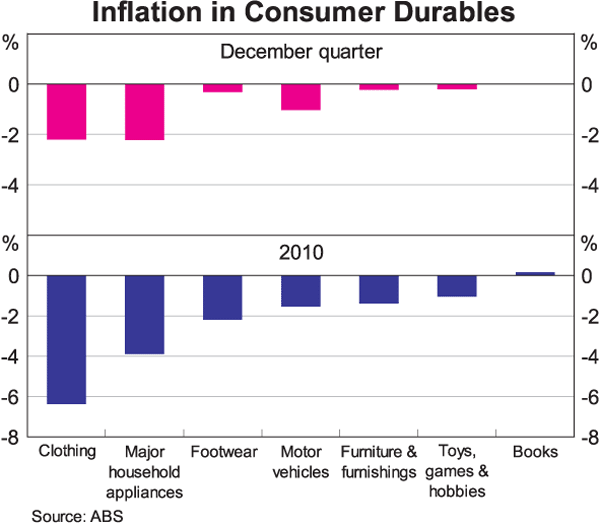
These pervasive price declines follow a substantial appreciation of the exchange rate and tariff cuts on a range of goods in early 2010. While it is difficult to be definitive, it is possible that the weak consumer spending has led to faster pass-through of these changes than suggested by previous experience. There has also been some moderation in inflation for goods and services whose prices are not directly influenced by the exchange rate, although the effects have been smaller. Overall, over 2010 the CPI increased by 2.7 per cent, with underlying measures of inflation running at about 2¼ per cent.
Updated Forecasts
I would now like to turn briefly to the Bank's updated forecasts.
Our central scenario remains for the economy to grow strongly over the next few years. The quarterly GDP outcomes in the near term are, however, going to be materially affected by the recent extreme weather events. These events significantly disrupted production in both the December and March quarters, especially in the coal industry. The Bank's current estimate – which remains subject to significant qualifications – is that total output in the March quarter will be around 1 per cent lower than it otherwise would have been. Given this mainly arises from a disruption to production, the decline in spending is likely to be somewhat smaller than 1 per cent.
Following the March quarter, we expect a strong rebound in output, as coal production recovers its fall and the rebuilding effort gets underway. Over 2011, our current forecast is for the economy to grow by around 4¼ per cent. This is higher than we were expecting three months ago, although this upward revision just reflects a lower starting point because of the decline in coal production in December 2010. Beyond the current year, our central scenario remains for the economy to grow in the 3¾ – 4 per cent range.
The recent extreme weather events will also have a noticeable effect on the near-term outcomes for inflation. Since the SMP was released we have been able to make a preliminary assessment of the likely effects of Cyclone Yasi, primarily on banana and other fruit and vegetable prices. The Bank now expects CPI inflation to be around 3 per cent over the year to June 2011, with the combined effect of floods and the cyclone likely to contribute around ½ percentage point to this outcome. This forecast represents an upward revision to the one published in the SMP, largely because of the expected increase in banana prices. Of course, with the price of bananas expected to fall back to more normal levels later in the year as production recovers, there is a period during 2012 when the year-ended inflation outcomes can be expected to be lower than at the time of the SMP. Looking through these weather-related effects, inflation is expected to gradually increase over the next couple of years to around 3 per cent in late 2012.
Finally, as always, these forecasts are subject to a number of uncertainties. As is the Bank's usual practice, we will continue to examine the ongoing flow of data on the global economy, domestic activity and prices and assess whether the outcomes remain consistent with our broad outlook. As I said at the outset, developments in global commodity markets and the attitudes of Australian consumers to spending are likely to have an important bearing on how our economy evolves over the next year or so.
Thank you for your time.
Endnotes
See also O'Connor and Orsmond (2007), ‘The Recent Rise in Commodity Prices: A Long-Run Perspective’, RBA Bulletin, April, pp 1–7. [1]
See Lowe (2010), ‘The Development of Asia: Risk and Returns for Australia’, Speech to NatStats 2010 Conference, Sydney, 16 September and, Lowe (2009) ‘The Growth of Asia and Some Implications for Australia’, Speech to Citi Australia Inaugural Australian Investment Conference, Sydney, 19 October. [2]